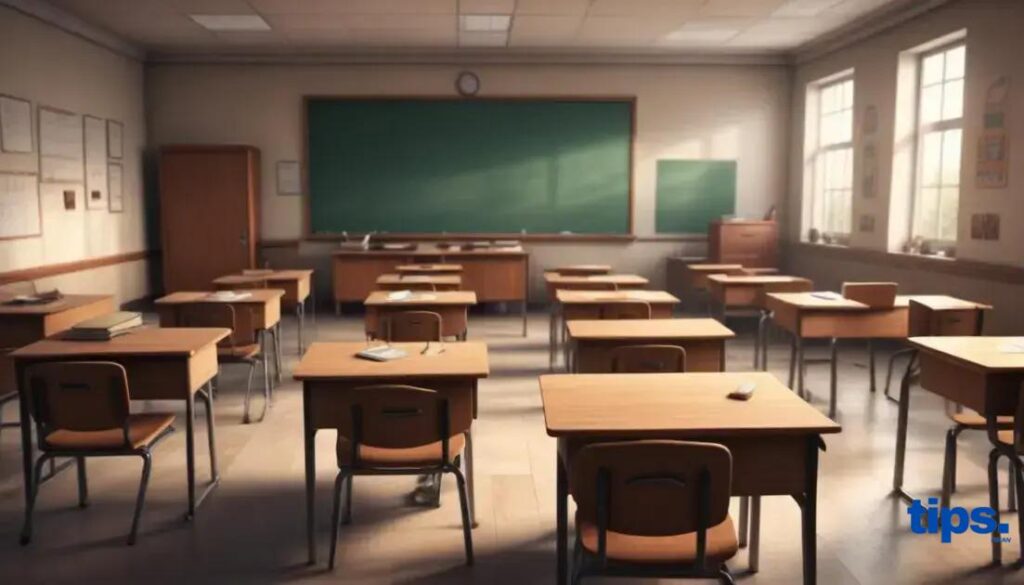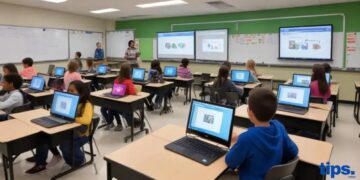Teacher shortages: a looming crisis for education

Anúncios
Teacher shortages significantly impact education quality, prompting the need for innovative strategies like enhanced compensation, community support, and technology use to attract and retain qualified educators.
Teacher shortages have become a pressing issue in today’s education system. With so many schools grappling to find qualified educators, what does this mean for our students and the future of learning?
Anúncios
Understanding the root causes of teacher shortages
Understanding the root causes of teacher shortages is crucial for finding effective solutions. Various factors contribute to this growing crisis in education.
One significant issue is **low salaries**. Many teachers report feeling underpaid compared to other professions requiring similar education levels. This often leads to dissatisfaction and early career exits.
Factors Contributing to Teacher Shortages
In addition to salary concerns, here are other important factors:
Anúncios
- High workloads: Teachers frequently face overwhelming responsibilities, leading to burnout.
- Lack of support: Insufficient resources and administrative backing can discourage prospective teachers.
- Limited career advancement: Few opportunities for growth within the profession can deter long-term commitment.
Moreover, factors such as increasing student enrollment without proportional increases in teacher hires exacerbate the situation. According to the National Center for Education Statistics, teacher demand continues to outpace supply in many regions.
Addressing these root causes is essential for mitigating teacher shortages and ensuring students receive the quality education they deserve. For more insights, visit Education Week.
Impact of teacher shortages on student learning
The impact of teacher shortages on student learning is significant and far-reaching. When schools lack sufficient qualified teachers, students often suffer in various ways.
One major consequence is larger class sizes. With fewer teachers available, the number of students in each classroom can increase. This can lead to less individual attention for each student, affecting their overall academic performance.
Moreover, teacher shortages can lead to less experienced educators filling positions. These individuals may lack the necessary training and confidence, which can hinder effective teaching.
Effects on Academic Performance
The following factors highlight how teacher shortages can directly influence students:
- Reduced engagement: Students may feel less motivated in overcrowded classrooms where teachers cannot provide adequate support.
- Lower test scores: Research shows that students taught by less experienced teachers often achieve lower academic results.
- Increased dropout rates: Struggling students may disengage from school altogether, leading to higher dropout rates.
Furthermore, the emotional and social aspects of learning are impacted. Students may struggle with behavioral issues when they do not have a consistent and supportive teacher.
For further insights into this important issue, visit Teaching Channel.
How schools are coping with fewer teachers
Schools are adapting to the realities of fewer teachers through various strategies. These measures aim to ensure that students continue to receive a quality education despite the challenges posed by teacher shortages.
One approach is to implement teacher collaboration. In this model, teachers work together to share best practices and resources. This teamwork helps enhance instructional quality even when staffing is limited.
Additionally, some schools are utilizing technology to bridge the gap. Online learning platforms and educational apps allow teachers to reach more students effectively. This can supplement in-person learning and provide resources to struggling students.
Strategies Schools are Using
Here are some common strategies schools are employing:
- Hiring substitutes: Schools are increasingly relying on substitute teachers to fill in gaps and maintain classroom stability.
- Multi-grade classrooms: Combining grades can maximize teacher resources, allowing one teacher to manage multiple grade levels.
- Support staff involvement: Paraprofessionals and support staff play vital roles in assisting with classroom management and instruction.
Moreover, schools are focusing on teacher retention initiatives to encourage existing teachers to stay. Creating supportive environments and offering professional development can help keep educators in their roles.
For more on how schools address staffing crises, check out American Federation of Teachers.
The role of teacher retention in addressing shortages

The role of teacher retention is crucial in addressing the ongoing issue of teacher shortages. Retaining experienced educators helps create stability in classrooms and improves student outcomes.
When teachers remain in their positions, they develop strong relationships with students and colleagues. This continuity is essential for fostering a positive learning environment.
Furthermore, retention reduces the need for frequent hiring and training of new teachers, which can disrupt the educational process.
Strategies for Improving Teacher Retention
There are several effective strategies schools can use to enhance teacher retention:
- Providing professional development: Offering opportunities for teachers to improve their skills can increase job satisfaction and engagement.
- Creating supportive work environments: Schools that prioritize collaboration and support among staff can significantly reduce turnover rates.
- Offering competitive salaries: Ensuring teachers receive fair compensation is a key factor in keeping them in their roles.
Additionally, recognizing teacher achievements and providing mental health support can further contribute to higher retention rates. It’s important for school districts to prioritize these elements to combat shortages effectively.
For further insights into teacher retention strategies, check out the Teaching Quality Initiative.
Innovative strategies to attract new educators
Attracting new educators is essential for addressing the ongoing teacher shortages. Schools and districts must employ innovative strategies to draw talented individuals into the profession.
One effective method is offering enhanced recruitment packages. These packages can include benefits such as signing bonuses, relocation assistance, and loan forgiveness programs for new teachers.
Another approach is to create partnerships with local colleges and universities. This can foster internship opportunities where students can gain real classroom experience while still in school.
Strategies to Attract New Educators
Below are some innovative strategies schools can implement:
- Streamlined hiring processes: Making the application process more efficient can attract more candidates.
- Flexible work opportunities: Offering part-time positions or remote teaching options can appeal to a broader range of applicants.
- Mentorship programs: Pairing new educators with experienced teachers can help new hires feel supported and valued.
Furthermore, promoting a positive school culture and highlighting professional growth opportunities can also make the teaching profession more appealing. Emphasizing the impact teachers have on students can inspire others to join the field.
For more insights on attracting educators, visit the U.S. Department of Education.
Community initiatives supporting local teachers
Community initiatives play a vital role in supporting local teachers and combating teacher shortages. These programs help create a strong network of resources and encouragement.
One effective initiative involves local businesses partnering with schools. These partnerships can provide sponsorships, scholarships, and resources for classroom supplies, benefiting both teachers and students.
Another approach is community mentoring programs. These programs connect experienced educators with new teachers, offering guidance, support, and a sense of camaraderie.
Key Community Initiatives
Some successful community initiatives include:
- Teacher appreciation events: Hosting events to recognize and reward teachers can boost morale and retention.
- Volunteer programs: Community members can support teachers by volunteering in classrooms, helping with lesson plans, and providing tutoring for students.
- Fundraising efforts: Organizing community fundraisers can help raise money for additional resources needed in classrooms.
These initiatives not only support teachers but also strengthen the relationship between schools and the communities they serve. To learn more about community support for education, visit National PTA.
| Topic | Action | Details |
|---|---|---|
| Root Causes | Identify challenges | Low pay, burnout, lack of support |
| Student Impact | Analyze effects | Larger classes, lower scores, less support |
| School Strategies | Adapt operations | Substitutes, tech, staff sharing |
| Retention Solutions | Keep good teachers | Better pay, PD, supportive culture |
| Recruitment Tactics | Attract new talent | Bonuses, internships, flexibility |
| Community Support | Engage locals | Volunteers, events, partnerships |
| Policy Reforms | Influence legislation | Loans, class sizes, certification |
| Future of Education | Plan for progress | Tech, hybrid models, new pathways |
Policy changes needed to combat teacher shortages
Policy changes are essential for effectively combating teacher shortages across the nation. Implementing thoughtful reforms can create a more attractive environment for educators.
One critical area is to enhance teacher compensation. Increasing salaries and providing competitive benefits can help retain current teachers and attract new talent.
Moreover, reducing class sizes is a vital policy change. Smaller classes allow teachers to provide more individualized attention to students, which improves teaching conditions and job satisfaction.
Necessary Policy Changes
Here are some key policy areas that need attention:
- Student loan forgiveness programs: Implementing programs for teachers can ease financial burdens and make the profession more appealing.
- Support for professional development: Providing funding for ongoing training and education helps teachers improve their skills and careers.
- Flexible hiring practices: Allowing alternative certification paths can diversify the teacher workforce and fill vacancies more rapidly.
Additionally, addressing issues like workload and administrative support can foster a healthier teaching environment. It’s crucial for school districts and policymakers to prioritize these changes to ensure adequate staffing in schools.
For more information on education policies, visit U.S. Department of Education.
The future of education amidst teacher shortages

The future of education amidst teacher shortages is a pressing concern for schools and communities. Finding solutions to this issue will shape how students learn in the coming years.
One possible future involves increased reliance on technology. Online learning platforms and educational software can help fill gaps left by absent teachers and provide personalized learning experiences.
Moreover, schools may adopt a more flexible curriculum that allows for different teaching methods. This adaptation can help utilize resources more efficiently and meet diverse student needs.
Innovative Approaches for the Future
Here are several innovative approaches that may define the future of education:
- Mixed delivery models: Combining in-person and online learning can make education more accessible and adaptable.
- Community involvement: Engaging local organizations and volunteers can help support teaching efforts and enrich learning.
- Alternative certification paths: Encouraging professionals from other fields to enter education through streamlined certification can help address teacher shortages.
Furthermore, focusing on teacher retention and support is essential for ensuring a stable educational environment. Establishing strong mentorship programs for new teachers and promoting wellness initiatives will be crucial.
For a comprehensive view on educational trends, visit Education Week.
In conclusion, addressing teacher shortages is vital for the future of education
Teacher shortages present significant challenges, but with innovative solutions and community support, we can create a more stable and effective educational environment.
By enhancing teacher retention, attracting new educators, and leveraging technology in classrooms, schools can better meet the needs of students.
Moreover, implementing supportive policies at the local and national levels can help ensure that all students have access to qualified teachers. Investing in education today will shape a brighter future for generations to come.





